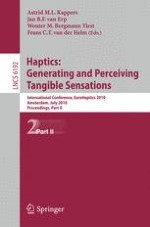2010 | Buch
Haptics: Generating and Perceiving Tangible Sensations
International Conference, EuroHaptics 2010, Amsterdam, July 8-10, 2010. Proceedings
herausgegeben von: Astrid M. L. Kappers, Jan B. F. van Erp, Wouter M. Bergmann Tiest, Frans C. T. van der Helm
Verlag: Springer Berlin Heidelberg
Buchreihe : Lecture Notes in Computer Science
